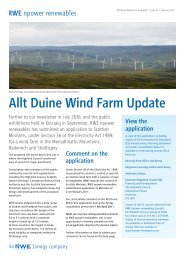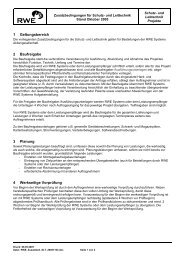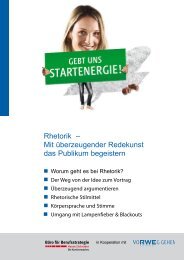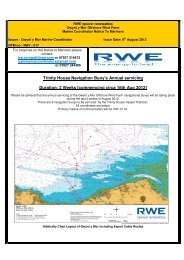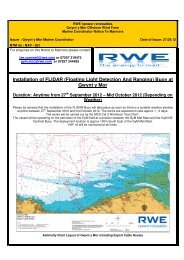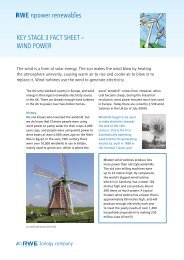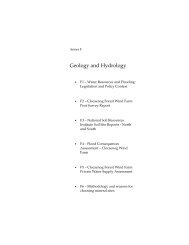Mynydd y Gwair Wind Farm - RWE.com
Mynydd y Gwair Wind Farm - RWE.com
Mynydd y Gwair Wind Farm - RWE.com
You also want an ePaper? Increase the reach of your titles
YUMPU automatically turns print PDFs into web optimized ePapers that Google loves.
9 Non Avian<br />
9.1 Introduction<br />
P a g e | 130<br />
<strong>Mynydd</strong> y <strong>Gwair</strong> <strong>Wind</strong> <strong>Farm</strong><br />
9.1.1 This chapter deals with the potential impacts of the proposed wind farm on ecological<br />
resources other than ornithological (avian or bird) assets.<br />
Explanation of Study Areas<br />
9.1.2 Ecological studies <strong>com</strong>menced in 2004, early in the evolution of the project, and baseline data<br />
has therefore been collected in various areas in and around the current application site.<br />
These various ecological study areas are shown in Figure 9.1.<br />
9.1.3 A much broader area of land than the current application site was covered initially, both to<br />
inform the development design and also to ensure that baseline use of the locality by wideranging<br />
species such as birds of prey was covered at a wider range than simply where<br />
turbines and other wind farm infrastructure were likely to be built. In response to initial<br />
surveys, scoping and consultations, additional areas of land were brought in for particular<br />
specialist studies.<br />
9.1.4 As the project design developed, and the preferred location of the turbine array and access<br />
infrastructure was decided, later phases in the baseline survey process became more<br />
focused. The wind turbine locations within the application site have themselves been selected<br />
by an iterative process taking into account the results from the wider ecological study area as<br />
well as other environmental and technical disciplines.<br />
9.1.5 The study areas shown on Figure 9.1 <strong>com</strong>prise:<br />
Main Study Area (MSA) – the Main Study Area equates to the original site boundary<br />
(see Chapter 3, Site Selection) at the beginning of the site design process in 2004. As a<br />
consequence it covers what is now the proposed wind farm site and also significant areas<br />
beyond the application site boundary. The boundaries of the MSA are roughly defined by<br />
Pentwyn Mawr to the north-west, Penlle‟r Castell to the north-east and they wrap around<br />
the Lliw Reservoir to extend onto Banc Maestir Mawr and <strong>Mynydd</strong> Garn Fach to the<br />
south.<br />
Bat Study Areas – targeted areas within the MSA where bat transects and emergence<br />
studies were carried out are shown on Figure 9.1. Each transect or emergence site is<br />
shown in greater detail in Appendices 9.2 to 9.5.<br />
Access Route Study Area - this <strong>com</strong>prises those parts of the proposed wind farm<br />
access route that lie outside the Main Study Area. By way of cross-reference with the<br />
<strong>Wind</strong> <strong>Farm</strong> Terminology Plan (Figure 1.3) this <strong>com</strong>prises Section 1 of the Access Route<br />
(new track) and all portions of Section 2 (existing road) where works might be needed<br />
that could affect habitats or species off the existing tarmac. It should be noted that the<br />
numbered points and „segments‟ used to describe individual parts of the route in this<br />
chapter are not the same as the „sections‟ used elsewhere in this ES. Studies along the<br />
access route formally included 30m either side of the proposed track but in practice the<br />
habitats are so open that features within 50-100m of the line were clearly visible. The<br />
Access Route Study Area with the numbered ecological survey points and segments is




